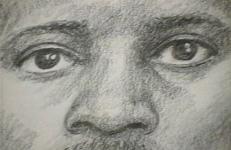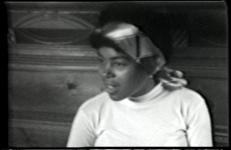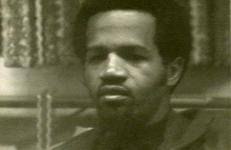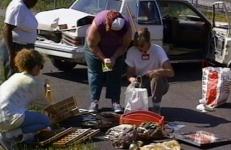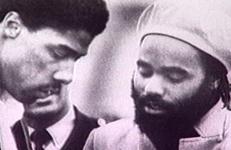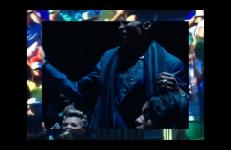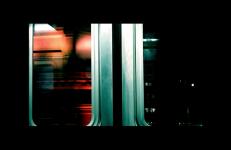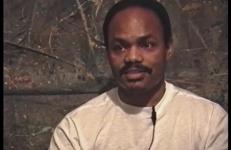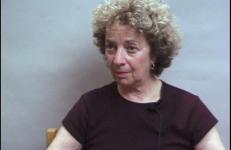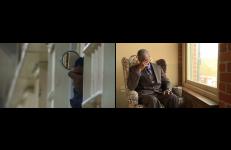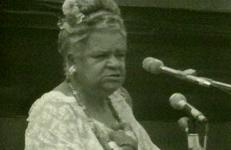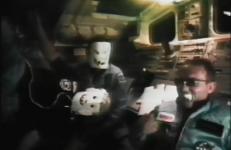Anthony Ramos' astute deconstruction of television news focuses on his part in the media coverage of President Jimmy Carter's 1977 declaration of amnesty for Vietnam draft evaders. Ramos, who had served an 18-month prison sentence for draft evasion, was interviewed by news reporter Gabe Pressman, whose film crew meets Ramos' video crew in a confrontation between technologies and sensibilities. At the time, some broadcast television news crews still used 16mm film, although the expensive transition to ENG (electronic news gathering) systems had begun in 1974.
Incarceration
One of Zaatari’s earliest experiments in documentary video, All Is Well on the Border emerged from the filmmaker’s desire to understand Israel’s occupation of Southern Lebanon following the 1982 Lebanon War. The video presents a series of testimonies by Lebanese citizens who were detained during the occupation, each presenting an image of resistance that falls outside the dominant narrative of liberation and solidarity promoted by the Lebanese left.
"I asked the inmates in my Art Group on the HIV/AIDS unit - Del Norte to talk about their experiences from the womb to the present moment. Here are their stories."
–Wendy Clarke
And They Came Riding Into Town on Black and Silver Horses looks at how media representations shape our perception of violence and violent crime, in effect creating racist stereotypes. Andrews suggests that the evidence against young Black men is gathered not at the scene of the crime, but at the scene of representation.
Featuring Arnold and Ahneva from Wendy Clarke's One on One video series, this video dialogue deeply connects the pair through discussion of Black brother and sisterhood. The two find comfort in sharing their own creative individualities, endeavors, and dreams. Their discussion and newly formed relationship poignantly touches upon the impact of mass incarceration within the Black community.
In October 1969, the Videofreex visited the home of wealthy political and social activist, Lucy Montgomery, as she was hosting the Black Panther Party of Chicago during one of their most fraught times – the period just after Chairman Bobby Seale was wrongfully imprisoned for inciting riots at the Democratic National Convention a year earlier. This video documents an interview with the wife of Bobby Seale, Artie Seale.
Portable Channel, a community documentary group in Rochester, New York, was one of the first small format video centers to have an ongoing relationship with a PBS affiliate (WXXI). Portapakers interviewed Sinclair Scott, a member of the negotiating team that went into Attica when the prisoners' rebelled at the federal prison in September 1971. Thirty-eight guards were taken hostage after prisoners' demands to improve their conditions were ignored. After a three day stand-off between inmates and authorities, Governor Nelson Rockefeller called in the National Guard.
This project on family violence, spanned two years and several sites across the country, and involved wrecked cars in sculptural installations. The cars were reconfigured by women and children who suffered violence at the hands of loved ones. Linked to each other through common experience, women from a domestic violence shelter in Pittsburgh, a family violence program at Bedford Hills prison, children from shelters in Niagara Falls and Cleveland, teenage girls in Oakland, and politicians on Staten Island all collaborated in making the cars.
Cloudless Blue Egress of Summer is a two-channel synchronized video installation. A composite of the two channels presented side by side in one video is available from Video Data Bank for educational use only.
In this conversation, Cathy Lee Crane (b. 1962) talks about her experience working with Harun Farocki on the groundbreaking video I Thought I Was Seeing Convicts (2000) and how the collaboration has informed her practice as a film and video maker. Crane also discusses the artistic approach and strategies that she takes when interacting with correctional institutions in the United States.
Deathrow Notebooks is structured around an interview with Mumia Abu-Jamal, a political prisoner who is on death row in Pennsylvania. Former president of the Association of Black Journalists, Abu-Jamal is a writer and creator of widely-broadcast radio programs who continues to write from prison. He was accused of killing a police officer, and in 1982 was convicted in a trial that contained many irregularities. To date, all of his appeals have failed.
Deathrow Notebooks is structured around an interview with Mumia Abu-Jamal, a political prisoner who is on death row in Pennsylvania. Former president of the Association of Black Journalists, Abu-Jamal is a writer and creator of widely-broadcast radio programs who continues to write from prison. He was accused of killing a police officer, and in 1982 was convicted in a trial that contained many irregularities. To date, all of his appeals have failed.
Frenzied voices on the Chicago Police Department’s scanner call for squad cars and reprisals during the 2020 uprising in response to the murders of George Floyd, Breonna Taylor, and Ahmaud Arbery, as Google Earth tracks the action through simulated aerial views of urban spaces and the vast Cook County Department of Corrections, the country’s third-largest jail system. In Christopher Harris’s Dreams Under Confinement, the prison, and the street merge into a shared carceral landscape.
At one point in END-LESSsestina, several men linking arms are made to walk, blindfolded, into a pool of water. We see thrashing and an expanse of blue, and finally, a lone tennis ball bobbing largely in the frame. Leading into this scene we hear a sports commentator contend, “it’s not just her out there, she’s representing America.” This line repeats itself throughout the video like a refrain; a pervasive echo of the American media’s criminalization of Serena Williams’ celebratory dance at the 2012 Olympics.
Sable Elyse Smith's How We Tell Stories to Children is a single channel video that combines found footage, music clips, and audio of the artist reading with video clips of her father recording himself from prison. Focal points and significant moments seem to always occur just offscreen, or quickly flash away.
For 5 months, Clarke held workshops with young women, ages 18-23 years old, who were incarcerated at the Ventura Youth Correctional Facility in Camarillo, California. As part of the weekly classes, the wards painted their faces and made digital self portraits. In the corner of the room was a video camera mounted on a tripod with a remote control. Each week the women sat alone in front of the camera and made a Diary tape. Inside Out includes several of the diaries.
Featuring Ken and Louise from Wendy Clarke's One on One video series, this video exchange encompasses a shared passion for music and pure emotional vulnerability that creates an incredibly intimate relationship between these two strangers throughout the project's evolution. Their connection is palpable, leaving the viewer envisioning a possible real life encounter between the two outside of the realm of this project.
In this interview, Phyllis Kornfeld, author of Cellblock Visions: Prison Art in America, describes her initial interest in working with prisoners in her native Oklahoma City, stemmed from an exploration of outsider artists. Detailing her first visit to a high security prison as a ‘mind blowing and breathtaking’ experience, Kornfeld discusses how she came to her realization that prisons are fertile environments for free form experimentation with the teaching process. She learned that through personalized art education, inmates could teach themselves to make positive contributions to society. - Kyle Riley
Natural Life is a feature-length experimental documentary challenging inequities in the U.S. juvenile justice system by depicting, through documentation and reenactment, the stories of five individuals who were sentenced to Life Without Parole (Natural Life) for crimes they committed as youth.
The youthful status and/or lesser culpability of these youths, their backgrounds, and their potential for rehabilitation were not taken into account at any point in the charging and sentencing process. The five will never be evaluated for change, difference or growth. They will remain in prison till they die.
PANEL originated as a performance-based, multi-channel video/sound installation, drawn from a transcript of a discussion at “Schizo Culture,” the notorious conference on schizophrenia and radical politics organized by Sylvère Lotringer at Columbia University in 1975.
A collection of love tapes made at the Metropolitan Correctional Center, a federal prison in New York City. The videos are part of Wendy Clarke's ongoing project, Love Tapes.
Two years after the riots and deaths at Attica, New York, a community day was organized at Greenhaven, a federal prison in Connecticut. Think Tank, a prisoners' group, coordinated efforts with African-American community members outside the prison walls to fight racism and poverty. The event was documented by People's Communication Network, a community video group founded by Bill Stephens, for cablecast in New York City, marking the first time an alternative video collective was allowed to document an event inside prison walls.
Featuring Ricky and Cecelia from Wendy Clarke's One on One video series, this video exchange between the pair explores topics concerning sibling love, decaying family relationships, and a shared interest in professional football. Although brief compared to the other parts within the One on One series, there is a glimmer of genuine human connection in their words.
Space Ghost compares the experiences of astronauts and prisoners, using popular depictions of space travel to illustrate the physical and existential aspects of incarceration: sensory deprivation, the perception of time as chaotic and indistinguishable, the displacement of losing face-to-face contact, and the sense of existing in a different but parallel universe with family and loved ones.
Physical comparisons such as the close living quarters, the intensity of the immediate environment, and sensory deprivation, soon give way to psychological ones: the isolation, the changing sense of time, and the experience of earth as distant, inaccessible, and desirable. The analogy extends to media representations that hold astronauts and prisoners in an inverse relationship: the super citizen vs. the super-predator. Astronauts, ceaselessly publicized, are frozen in time and memory whereas prisoners, anonymous and ignored, age without being remembered.
Moments of resistance are collapsed and woven together; from documentation of the Indigenous led occupation of Alcatraz, to the reclamation of Cahokia and the repatriation of the ancestors, to one’s reflections on their body as they exist in the world today, these are gestures that meditate on the carceral inception and nature of the reservation system, and where sovereignty and belligerence intersect and diverge.
Sound by Courtney Asztalos
Music by Room Thirteen
Commissioned by the San Jose Museum of Art and the Institute of Arts and Sciences at UC Santa Cruz.







